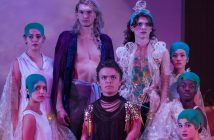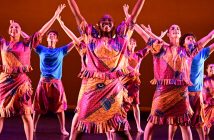The Department of Theology and Orthodox Christian Studies program is hosting a noted Serbian artist and professor of the history and theory of art this semester on a Fulbright scholarship.
Davor Dzalto, Ph.D., studies contemporary art and how it relates to the theory of personhood in Orthodox Christianity. Additionally, he analyzes the semiotics of medieval religious iconography and contemporary images and how they influence people’s perceptions of reality.
While Dzalto is at Fordham, he will collaborate with Aristotle Papanikolaou, Ph.D., associate professor of theology and co-founding director of the Orthodox Christian Studies program.
“The theology department and Orthodox Christian Studies program will be enriched by the presence of an international scholar who is working to relate the Christian tradition to contemporary thought,” Papanikolaou said.
“We will benefit by hearing about his work and having conversations with him,” he said. “Hosting Dr. Dzalto will facilitate our mission to foster an ongoing dialogue between the Catholic and the Orthodox Christians traditions.”
In addition, Dzalto will spend time at St. Vladimir’s Orthodox Theological Seminary in Yonkers, N.Y., and the Holy Cross Greek Orthodox School of Theology. He will travel outside New York to give lectures in Chicago and at Indiana University and the University of Oklahoma.
story continues below

In addition to studying at Fordham, Davor Dzalto, Ph.D., will lecture in Chicago, Indiana and Oklahoma. Photo by Marie-Christine Fritsch
His current research compares some contemporary theories of image—developed by Jean Baudrillard and Slavoj Zizek—to the theology of icons in Orthodox Christianity.
“There are many interesting points that can be mutually related in both of these conceptualizations of images,” said Dzalto, whose work is influenced mainly by Nikolai Berdyaev and John Zizioulas.
“The theology of icons was developed during the iconoclastic controversy—in the eight and ninth centuries,” he said. “At that time, a very specific theory of image was formulated, which determined the place of icons in the liturgy as well as their meaning in respect to history and eschatology.
“One of the very fundamental properties of icons is that they represent not ordinary portraits, but ‘eschatological portraits’ of human people. This way, icons change the way we perceive reality and its significance,” he said.
Dzalto pointed out that, in a certain sense, images grew to be more important than actual objects.
“In the ninth century, Patriarch Nicephorus claimed that if we remove images, then the whole world disappears,” he explained. “The same idea is evident in contemporary theories of image; in Zizek’s words, ‘Images are the reality,’ so if they are removed, there is nothing left.”
According to Dzalto, this means that “images must be there to preserve, in some sense, the meaning of the world.”
“It’s remarkable to me how—after so many centuries—we have come again to the point where we think of images as things that are, in some sense, reality—that we can’t approach the reality without images,” he said.
– Jenny Hirsch


